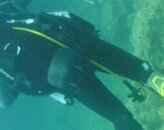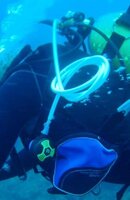People argue that a diver who has taken a working regulator from a buddy will bolt to the surface, putting the buddy in peril, but that same diver in a buddy breathing situation will calmly take two breaths, hand the regulator back to the buddy, and then wait patiently with no regulator while the buddy takes two breaths.
I have some real-world experience with this.
In the summer of 1985 I assisted the LDS with rescue training by being the "victim". My gear, and the gear of the students in training did include a proper octopus (which was far from universal back then) but stowing it where it could be found easily was not yet the norm.
On a particular day I was in 30ft of water laying face down on the bottom waiting to be found. There were no safety divers in the water and I was solo. The rescue diver (who was also solo) found me face down and did some things wrong, which started by rolling me over in such a way that his arm got in between the regulator hose and my body and pulled the regulator out of my mouth on the roll. This he didn't notice.
He then proceeded to "lift" me but in the process had both of my arms held in such a way that I couldn't get either of them loose. Obviously I couldn't retrieve my regulator. I initially thought I would just hold on until we got to the surface since most divers ascend way too fast with this scenario. This time, however, the ascent was painfully slow. About 1/2 way to the surface I realized that I wasn't going to make it. It was like he had ALL THE TIME IN THE WORLD, which was NOT how I was feeling just then!
I struggled to get an arm free but the more I struggled the firmer his grip became because he thought it was part of the scenario (or so he told me after the fact).
Realizing that struggling wasn't going to do it, I let my body go limp until his grip loosened and then I RIPPED one of my arms free, which caused him to turn around with the following look on his face:

at that point, I ... er... "acquired" his primary and started breathing from it. I hadn't reached the point of panic yet but my body was heaving to take a breath and I wasn't about to go looking for my own reg or take "no" for an answer. So I just took his primary... and to his credit he let me have it without pause.
This lead to us buddy breathing since neither one of us had any idea where his octopus was. Initially I didn't think to give it back until he reminded me by tugging on the hose. That was all the reminder I needed to start buddy breathing "by the book". We finished the ascent in this manner.
I'm not saying that my reaction is indicative of how every diver would have responded in that situation but I got some insights from this that affected my diving, including how I teach AAS:
- 1. If someone wants a regulator, give them one. I have a 5-alarm allergy for instructors who teach to expose the octopus and "hide" the primary in case an OOA diver tries to take it. In my opinion, that's just plain wrong. Wrong Wrong Wrong. The answer to this is flexibility. If that guy (despite his mistakes) had refused to give me his primary then I may have drowned. His flexibility in that situation was instrumental in handling that emergency. That's a big part of my "A" from ABC. Give the diver whatever he needs and stay flexible if they don't follow protocol.
- 2. Never ever EVER attach your octopus in such a way that you are unable to retrieve it yourself and/or don't know where it is. That's kind of related to "A" because A means "air for everyone" and if part of your response to an OOA diver means you give them your primary then you bloody well better know where your own octopus is because you're going to need it. Especially now since buddy breathing has been taken out of the curriculum and you do not want to try figuring out how it works when the poop is already flying. Moreover, someone who takes your primary may need to be reminded to give it back (as I was) and depending on personalities the reminder may not be enough. I "snapped out" of it with a gentle reminder but I teach my students that if someone takes your primary that you should let them have it and then use your own octopus in the "A" phase. This is the main reason why I think the long-hose and bungee backup is better, because no matter what happens you always know where the octopus is.
- 3. Once the air situation is sorted out the stress subsides fairly quickly and you can move on to other things. In this case we already had a hold of each other but the seed of my "B" from ABC got planted here too because what made the buddy breathing ascent work for us was the reflex that we both had to get neutral and then give each other an 'OK' and "Ascend" sign (the "C").
R..





